
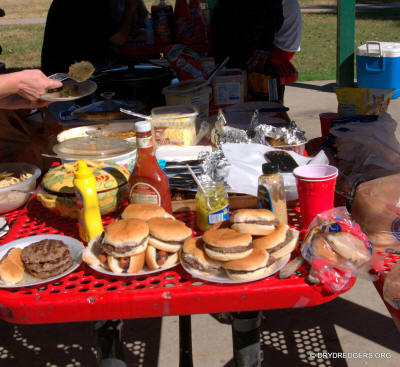
Photos and words by Bill Heimbrock
For the Dry Dredgers September 2014 field trip, the Kentucky Paleontological Society hosted a picnic and field trip to several locations in Central Kentucky. The KPS supplied the hamburgers, hot dogs, buns, plates and utensils and the members of both groups brought side dishes, snacks and desserts. We had a decent turn-out of members from both groups and everyone seemed to enjoy the wide variety of food. A special thanks to Dan Phelps who was our grill master and arranged the trip.
Site 1: Private Property
After the delicious meal, we headed out to our first site. The KPS was able to arrange for us to venture onto private property. We want to thank the property owners for their generous permission.
The private property exposed the Pennington Formation of the Upper Mississippian System. From the eroded dirt, we were picking up plentiful blastoids, crinoid stems, a few crinoid calyxes, brachiopods and bryozoans. I found my first blastoid in the first 60 seconds of arriving at the site!
Site 1: Blastoids
The abundant blastoids we found on site 1 (Pennington Fm.) were all Pentremites sp..
Some loose stems of blastoids were found too. Here's a couple.
Site 1: Crinoids
Some partial crinoid calyxes (crowns) were found. Not sure on the identity of these.
We also found some crinoid spines ("wing plates") from
Pterotocrinus sp..
They're very common in Chesterian-age strata. (Horowitz
1965 plate 5). Thanks to Kyle Hartshorn for identifying these!
Mostly we found the stems of crinoids. The unique thing about these stems that we don't have in our Cincinnatian Ordovician crinoid stems is that these Mississippian varieties have cirri coming off of them.
Bryozoans
At the first site, we found some of the cork-screw bryozoan Archimedes sp., but they were mostly encased in rock.
We also found a few beautiful fenestrate bryozoans.
Brachiopods
A huge variety of brachiopods were found on the first site. At this time, I will
show the pictures below without identifications but will later fill in the ID's.
Site 2
The second site we visited was a road cut in Central Kentucky that exposes the Paragon Formation at the top (Late Mississippian). This site was huge, but we stuck to the gutter and first shelf. As you can see from these pictures, the road cut was steep and the climbing was tough. But the fossils weathering out from the softer shale layers were excellently preserved.
Fossils Found at the Second Site
Second Site: Blastoids
It was amazing. The blastoids were just laying around already perfectly clean and free from the rock matrix.
All of the blastoids I saw and photographed at this site were Pentremites sp.. You can tell from these photos how abundant and how perfectly preserved they were.
We found a few "diamonds" that look to be the basal plates of these blastoids.
I'll have to check to make sure that's what the are and update this page.
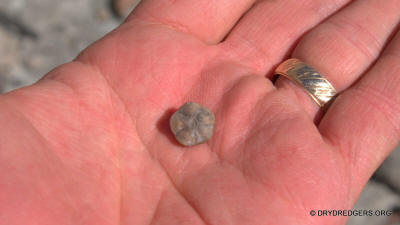
We also found some more recognizable blastoid stems and basal plates. (next 2
pics)
Second Site: Crinoids
As far as I saw, only partial crinoid calyxes were found. Here are a couple of
bases to crinoid calyxes we saw at site #2.
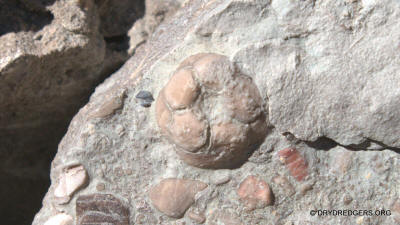
Second Site: Bryozoans
This second site was loaded with excellently preserved cork-screw bryozoans, Archimedes sp..
Large numbers of fenestrate bryozoans were found at site #2 also.
Second Site: Horn Coral
We actually found more blastoids than horn coral.
Second Site: Oncolites
One of the less common finds on site#2 was this really nice slab of nodular minerals that are likely Oncolites. If they are, they were started by cyanobacterial growth forming concentric layers.
Site 3
The third site to which Dan took us was another road cut that exposes the Providence Member of the Borden Formation (Early Mississippian). Here we were told that if we break open the ironstone nodules found weathering out of the hillside, we would find a fossil in the center.
Third Site: Ironstone Nodules
We began breaking open come of the iron-rich nodules we found.Among the best fossils we found in the center were ammonoids, in this case Mississippian nautiloid cephalopods.
Here's a really nice cephalopod we found in the center of a nodule.
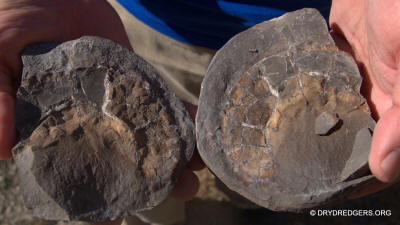
In another case, the entire nodule was filled with a cephalopod.
Here's another example of small cephalopod in the center of a nodule.
In another case, we found a crinoid stem in the center.
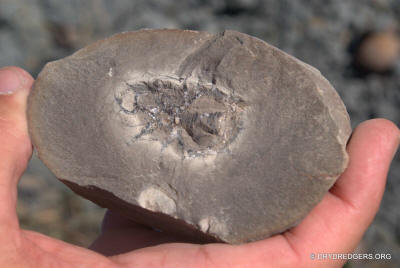
That's all for this trip. The Dry Dredgers wish to thank the Kentucky Paleontological Society and especially Dan Phelps for hosting this year's picnic/field trip and for choosing some excellent fossil sites.
Back to the Field Trip Index Page
Return to Dry Dredgers Home Page
The Dry Dredgers and individual contributors reserve the
rights to all information, images, and content presented here. Permission to
reproduce in any fashion, must be requested in writing to admin@drydredgers.org.
www.drydredgers.org is designed and maintained by Bill Heimbrock.